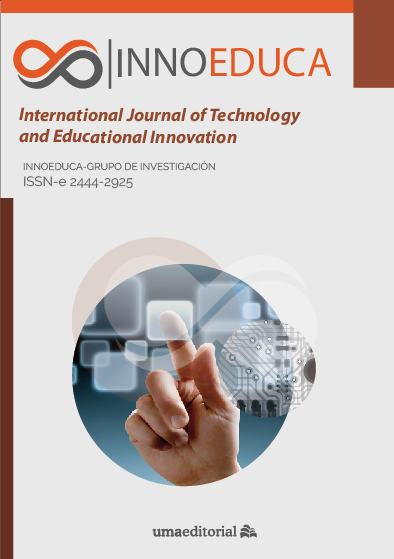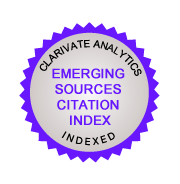Personal and teaching factors related to university professors’ stress levels in the face of COVID-19
DOI:
https://doi.org/10.24310/innoeduca.2022.v8i1.11920Keywords:
COVID-19, Higher Education, stress variablesAbstract
The pandemic caused by COVID-19 has entailed a radical change in teaching, which occurred suddenly and without the possibility to adequately train university professors. Factors such as personal situation, prior training in digital competencies for online teaching, or sex can play an important role in the stress levels of professors. The objective of this study was to understand how these factors affected professors’ stress levels during a period of the pandemic. Through a survey carried out via email, a total of 123 teachers from different Spanish universities were contacted, 96 of whom responded. The results obtained establish a positive correlation between the stress felt by professors and sex, number of children, prior knowledge of online teaching systems, as well as the use of social networks. These preliminary findings could serve to establish preventive protocols that would help to improve the quality of life of professors and, consequently, the quality of university teaching in similar situations that may arise in the future.
Downloads
Metrics
Publication Facts
Reviewer profiles N/A
Author statements
Indexed in
-
—
- Academic society
- N/A
- Publisher
- Universidad de Málaga
References
Angeles, L. (2010). Children and life satisfaction. Journal of Happiness Studies, 11(4), 523–538. https://doi.org/10.1007/s10902-009-9168-z
Chaplain, R. P. (2008). Stress and psychological distress among trainee secondary teachers in England. Educational Psychology, 28(2), 195–209. https://doi.org/10.1080/01443410701491858
Chen, Q., Liang, M., Li, Y., Guo, J., Fei, D., Wang, L., He, L., Sheng, C., Cai, Y., Li, X., Wang, J., & Zhang, Z. (2020). Mental health care for medical staff in China during the COVID-19 outbreak. The Lancet Psychiatry, 7(4), e15–e16. https://doi.org/10.1016/S2215-0366(20)30078-X
De Pietri, S., & Chiorri, C. (2021). Early impact of COVID-19 quarantine on the perceived change of anxiety symptoms in a non-clinical, non-infected Italian sample. Journal of Affective Disorders Reports, 4(December 2020), 100078. https://doi.org/10.1016/j.jadr.2021.100078
Dhawan, S. (2020). Online Learning: A Panacea in the Time of COVID-19 Crisis. Journal of Educational Technology Systems, 49(1), 5–22. https://doi.org/10.1177/0047239520934018
Forte, G., Favieri, F., Tambelli, R., & Casagrande, M. (2020). COVID-19 pandemic in the italian population: Validation of a post-traumatic stress disorder questionnaire and prevalence of PTSD symptomatology. International Journal of Environmental Research and Public Health, 17(11), 1–16. https://doi.org/10.3390/ijerph17114151
Kang, L., Li, Y., Hu, S., Chen, M., Yang, C., Yang, B. X., Wang, Y., Hu, J., Lai, J., Ma, X., Chen, J., Guan, L., Wang, G., Ma, H., & Liu, Z. (2020). The mental health of medical workers in Wuhan, China dealing with the 2019 novel coronavirus. The Lancet Psychiatry, 7(3), e14. https://doi.org/10.1016/S2215-0366(20)30047-X
Kim, H. W., Chan, H. C., & Chan, Y. P. (2007). A balanced thinking-feelings model of information systems continuance. International Journal of Human Computer Studies, 65(6), 511–525. https://doi.org/10.1016/j.ijhcs.2006.11.009
Klassen, R. M. (2010). Teacher stress: The mediating role of collective efficacy beliefs. Journal of Educational Research, 103(5), 342–350. https://doi.org/10.1080/00220670903383069
Kowal, M., Coll-Martín, T., Ikizer, G., Rasmussen, J., Eichel, K., Studzi?ska, A., Kosza?kowska, K., Karwowski, M., Najmussaqib, A., Pankowski, D., Lieberoth, A., & Ahmed, O. (2020). Who is the Most Stressed During the COVID-19 Pandemic? Data From 26 Countries and Areas. Applied Psychology: Health and Well-Being, 12(4), 946–966. https://doi.org/10.1111/aphw.12234
Li, H., & Yu, J. (2020). Learners’ continuance participation intention of collaborative group project in virtual learning environment: an extended TAM perspective. Journal of Data, Information and Management, 2(1), 39–53. https://doi.org/10.1007/s42488-019-00017-8
Marek, M. W., Chew, C. S., & Wu, W. V. (2020). Teacher Experiences in Converting Classes to Distance Learning in the COVID-19 Pandemic. International Journal of Distance Education Technologies, 19(1), 89–109. https://doi.org/10.4018/ijdet.20210101.oa3
Moccia, L., Janiri, D., Pepe, M., Dattoli, L., Molinaro, M., De Martin, V., Chieffo, D., Janiri, L., Fiorillo, A., Sani, G., & Di Nicola, M. (2020). Affective temperament, attachment style, and the psychological impact of the Covid-19 outbreak: an early report on the Italian general population. Brain, Behavior and Inmunity, 14(4), 337–339.
Moriana, J. A., & Herruzo, J. (2004). Estrés y burnout en profesores. International Journal of Clinical and Health Psychology, 4(3), 597–621.
Panisoara, I. O., Lazar, I., Panisoara, G., Chirca, R., & Ursu, A. S. (2020). Motivation and continuance intention towards online instruction among teachers during the COVID-19 pandemic: The mediating effect of burnout and technostress. International Journal of Environmental Research and Public Health, 17(21), 1–29. https://doi.org/10.3390/ijerph17218002
Partlow, K. M., & Gibbs, W. J. (2003). Indicators of constructivist principles in internet-based courses. Journal of Computing in Higher Education, 14(2), 68–97. https://doi.org/10.1007/BF02940939
Rajkumar, R. P. (2020). Since January 2020 Elsevier has created a COVID-19 resource centre with free information in English and Mandarin on the novel coronavirus COVID- 19 . The COVID-19 resource centre is hosted on Elsevier Connect , the company ’ s public news and information. Asian Journal of Psychiatry, 52(March), 1–5.
Rapanta, C., Botturi, L., Goodyear, P., Guàrdia, L., & Koole, M. (2020). Online University Teaching During and After the Covid-19 Crisis: Refocusing Teacher Presence and Learning Activity. Postdigital Science and Education, 2(3), 923–945. https://doi.org/10.1007/s42438-020-00155-y
Shea, P. (2019). Bridges and Barriers To Teaching Online College Courses: a Study of Experienced Online Faculty in Thirty- Six Colleges. Online Learning, 11(2), 73–128. https://doi.org/10.24059/olj.v11i2.1728
Silva, J., & Maturana, D. (2017). Una propuesta de modelo para introducir metodologías activas en educación superior. Innovación Educativa, 17(73), 117–131.
Suothwick, S. M., & Charney, D. S. (2018). Resilience: the Science of mastering life´s greatest challenges. Cambridge University Press. https://doi.org/10.1017/9781108349246
Tejada, J. (1999). El formador ante las TIC: nuevos roles y competencias profesionales. Comunicación Y Pedagogía, (158), 17–26. https://www.researchgate.net/publication/259997330_El_formador_ante_las_NTIC_nuevos_roles_y_competencias_profesionales
Tejada, J. (2000). La educación en el marco de una sociedad global: algunos principios y nuevas exigencias. Profesorado. Revista de Curriculum y Formación del Profesorado 4(1), 13-26.
Wang, L. Y. K., Lew, S. L., Lau, S. H., & Leow, M. C. (2019). Usability factors predicting continuance of intention to use cloud e-learning application. Heliyon, 5(6), e01788. https://doi.org/10.1016/j.heliyon.2019.e01788
Downloads
Published
How to Cite
Issue
Section
License
All contents published by Innoeduca. International Journal of Technology and Educational Innovation are subject to Creative Commons Attribution-Nocomercial-NoDerivatives 4.0 International License, whose complete text can be consulted at https://creativecommons.org/licenses/by-nc-nd/4.0/legalcode. Thus, copying, distribution, public communication, derivative works and commercial use of content are permitted as of the aforementioned issue provided that the source and the author of the text are cited.
It is the responsibility of the authors to obtain the necessary permits for images that are subject to copyright.

This work is licensed under a Creative Commons Attribution-NonCommercial-NoDerivatives 4.0 International License.













242.png)








